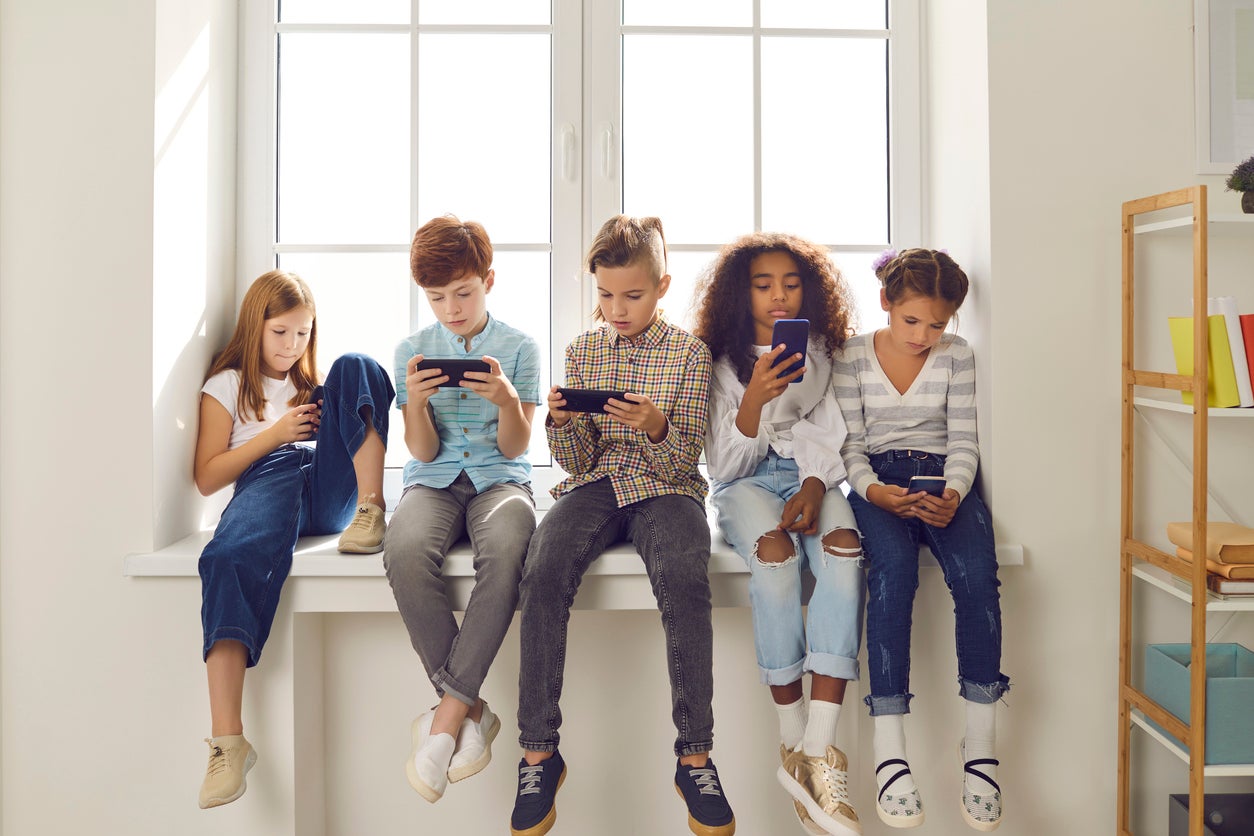Your support helps us to tell the story
Our mission is to deliver unbiased, fact-based reporting that holds power to account and exposes the truth.
Whether $5 or $50, every contribution counts.
Support us to deliver journalism without an agenda.
My sister, who works at a specialist college, was recently telling me that phones are the number one issue that she and her colleagues are struggling with. Students have them out at all times, clutched in their hands like shiny, black security blankets. Her class will message each other from across the room during lessons, or scroll social media, or listen to music; meanwhile, she’s desperately trying to claw their attention back and get them to engage with the real world.
Screens and teens: it’s a combination that’s become increasingly tricky to navigate over the last decade. The switch from what I think of as “analogue” phones – those with buttons but no internet – to smartphones, compounded by an upsurge in digital living during pandemic lockdowns, has resulted in 46 per cent of adolescents reporting they are online “almost constantly”. Some 97 per cent of children have a smartphone by the age of 12, according to Ofcom data.
In February, new battle lines were drawn in this ongoing war. Government ministers confirmed plans to ban them in schools in England, with the Department for Education (DfE) issuing guidance to help teachers with implementation. Gillian Keegan, the education secretary, said the DfE believed the guidance would “empower” headteachers to exorcise these digital demons, and “would send a clear message about consistency”.
“You go to school, you go to learn, you go to create those friendships, you go to speak to people and socialise and you go to get educated,” she told BBC Radio 4’s Today programme. “You don’t go to sit on your mobile phone or to send messages while you could actually talk to somebody.”

St Albans in Hertfordshire has gone one substantial step further, announcing in May its intention to become the first British city to go smartphone-free for under 14s. Parents received a joint letter from the primary schools consortium encouraging them to delay buying the devices for their children. Meanwhile, the Smartphone Free Childhood (SFC) movement’s online pledge to withhold smartphones from children until they are at least 14 has attracted signatures from 37,000 parents nationwide, representing more than 56,000 children, while a quarter of British schools (8,100) have signed the pact.
The reason this is so pressing isn’t simply that tweens and teens aren’t paying proper attention in class. It has a far more sinister impact on children and young people’s mental health, according to the book, The Anxious Generation, written by social psychologist Jonathan Haidt. He presents the compelling argument that the uptick in time spent online has coincided with an alarming mental health crisis all over the world.
Between 2010 and 2015, suicide rates among 10 to 14-year-old girls and boys increased by 167 and 92 per cent respectively. Self-harm rates for teenage girls in the UK soared by 78 per cent. Anxiety diagnoses for those aged 18 to 25 jumped by 92 per cent. During this same five-year period, smartphones reached a majority of US households – they were adopted faster than any other communication technology in human history. There is a tangible link, too, between screentime and poor mental health, reveals Haidt: nearly 40 per cent of teenage girls who spend over five hours on social media a day have been diagnosed with clinical depression.
Childhood and adolescence have been “rewired”, claims Haidt. Referencing the shift that started at the turn of the millennium, when tech companies began creating a set of world-changing products based around exploiting the rapidly expanding capabilities of the internet, Haidt paints a deeply concerning picture.
“The companies had done little or no research on the mental health effects of their products on children and adolescents, and they shared no data with researchers studying the health effects. When faced with growing evidence that their products were harming young people, they mostly engaged in denial, obfuscation, and public relations campaigns,” he says.
Business models that relied on maximising engagement using psychological tricks were the “worst offenders”, he says, adding that they hooked children “during vulnerable developmental stages, while their brains were rapidly rewiring in response to incoming stimulation”. For girls, some of the greatest damage was inflicted by social media; for boys, video games and porn sites had the most chilling impacts.
“By designing a firehouse of addictive content that entered through kids’ eyes and ears, and by displacing physical play and in-person socialising, these companies have rewired childhood and changed human development on an almost unimaginable scale,” Haidt writes damningly. Companies are accused of behaving like the tobacco and vaping industries, designing highly addictive products and skirting laws in order to sell them to minors.
These companies have rewired childhood and changed human development on an almost unimaginable scale
It makes for terrifying reading. Developmentally, children’s brains are not at all adapted to cope with all of the above. The reward-seeking parts of the brain mature earlier, but the frontal cortex, responsible for self-control and will-power, isn’t operating on all cylinders till our mid-twenties – creating a dangerously toxic cocktail when you throw in algorithms advanced enough to even hold adults’ attention hostage for hours at a time.
Haidt tells the story of one Boston mother, representative of many of the parents he’s worked with, who said she felt she had “lost” her 14-year-old daughter, Emily. She recounted how she and her husband had tried to reduce the amount of time Emily spent on Instagram. “In one distressing episode, she got into her mother’s phone, disabled the monitoring software, and threatened to kill herself if her parents reinstalled it.”
Lest you think that the sudden deterioration in young people’s mental health is down to current events – for example, political crises, the rise of right-wing and populist movements, Brexit, Donald Trump and all the rest – Haidt compared a number of countries that were culturally similar enough but experienced different major news events over the same time period, including Canada, the UK and Nordic countries. All experienced a near-identical shift starting in the early 2010s.
There are four foundational “harms” triggered by the new “phone-based childhood”, puts forth Haidt: social deprivation, sleep deprivation, attention fragmentation and addiction. The first is obvious. “Children need a lot of time to play with each other, face to face, to foster social development,” says Haidt. Teens who spend more time in-person with their peers have better mental health, according to research, while those who spend more time on social media are more likely to suffer from depression and anxiety. But the percentage of 17 to 18-year-olds in the US who said they hung out with their friends “almost every day” dropped dramatically from 2009 onwards. Time spent interacting with people online has replaced IRL equivalents – and adolescent mental health has taken a corresponding nosedive.

The second is less clear-cut, but an upsurge in sleep problems – that had levelled off in the early 2010s but continued on a steep upward trajectory in 2013 – has been linked to the phone-based childhood. There are “significant associations” between high social media use and poor sleep, according to a review of 36 correlational studies. One UK data set found that heavy use of screen media “was associated with shorter sleep duration, longer sleep latency and more mid-sleep awakenings”. Teenagers need more sleep than adults, particularly during puberty; those who are sleep-deprived don’t concentrate or retain information as well as those who have had eight hours a night.
Adults will be very familiar with number three: attention fragmentation. The double-digit tabs and the constant pinging of Slack and countless WhatsApp groups are hard enough to juggle as a fully-fledged grown-up. One study found that the average teenager gets 192 alerts or notifications per day from social media and communication apps – the equivalent of 11 per waking hour, or one every five minutes. “No matter how hard it is for an adult to stay committed to one mental road, it is far harder for an adolescent, who has an immature frontal cortex and therefore limited ability to say no to off-ramps,” writes Haidt. He argues that the never-ending stream of interruptions “takes a toll on young people’s ability to think and may leave permanent marks in their rapidly reconfiguring brains”.
And finally, addiction. This stems from app creators designing products that dispense variable “rewards”, triggering dopamine hits that make us feel good. They use “every trick in the psychologists’ tool kit to hook users as deeply as slot machines hook gamblers”. Adolescents are much more susceptible to these “tricks” than adults, due to the aforementioned frontal cortex, which isn’t mature until age 20 and beyond.
With all of this at work, is it any wonder that Generation Z and those that came after are in crisis? And is there any way of breaking this hugely detrimental pattern? Yes, according to Haidt – but it will take robust and collective action to delay the age at which children get smartphones and social media accounts, making the switch from a phone-based childhood back to a play-based one.
No matter how hard it is for an adult to stay committed to one mental road, it is far harder for an adolescent
Voluntary coordination can be a useful tool here – for example, a group of parents at a school can collectively decide none of their children will be allowed phones until a certain age. This group decision means kids don’t feel left out in the same way. If you can reach critical mass, not having a phone even becomes the norm– hence why St Albans’ coordinated effort to ban smartphones for children under 14 across the board could be so powerful.
Haidt also highlights technological solutions, such as the introduction of better “basic” phones to avoid giving children smartphones; lockable pouches for phones; and quick and easy age verification methods. Finally, governments need to step in. Laws such as requiring all social media companies to verify the ages of new users, and policies demanding schools enforce a “phones in lockers” rule during the school day, could have a big impact.
The main thing to stress is that it’s not too late to make a change, says Haidt: “When new consumer products are found to be dangerous, especially for children, we recall them and keep them off the market until the manufacturer corrects the design. In 2010, teens, parents, schools and even tech companies didn’t know that smartphones and social media had so many harmful effects. Now we do.”
‘The Anxious Generation: How the Great Rewiring of Childhood Is Causing an Epidemic of Mental Illness’ by Jonathan Haidt is published on 26 March by Allen Lane for £25


